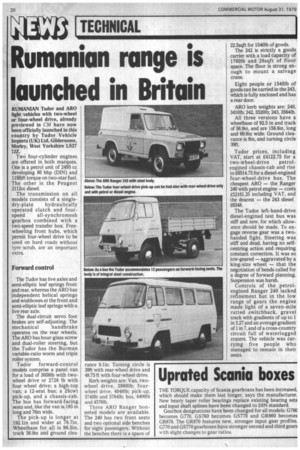Rumanian range is launched in Britain
Page 22

If you've noticed an error in this article please click here to report it so we can fix it.
RUMANIAN Tudor and ARO light vehicles with two-wheel or four-wheel drive, already previewed in CM have now been officially launched in this country by Tudor Vehicle Imports (UK) Ltd, Gildersome, Morley, West Yorkshire LS27 7JZ.
Two four-cylinder engines are offered in both marques. One is a petrol unit of 2495 cc developing 80 bhp (DIN) and 1191bft torque on two-star fuel. The other is the Peugeot 2112cc diesel.
The transmission on all models consists of a single dry-plate hydraulically operated clutch and four speed all-synchromesh gearbox combined with a two-speed transfer box. Freewheeling front hubs, which permit four-wheel drive to be used on hard roads without tyre scrub, are an important extra.
Forward control
The Tudor has live axles and semi-elliptic leaf springs front and rear, whereas the ARO has independent helical springs and wishbones at the front and semi-elliptic leaf springs with a live rear axle.
The dual-circuit servo foot brakes are self-adjusting. The mechanical handbrake operates on the rear wheels. The ARO has hour-glass screw and dual-roller steering, but the Tudor has the Burman variable-ratio worm and triple roller system.
Tudor forward-control models comprise a panel van for a load of 30581b with twowheel drive or 2728 lb with four wheel drive; a high-top van; a 12-seat bus; a 25cwt pick-up, and a chassis-cab. The bus has forward-facing seats and, like the van is, 185 in long and 76in wide.
The pick-up is longer at 192.1in and wider at 78.7in. Wheelbase for all is 96.5in, track 56.9in and ground clea rance 9.1in. Turning circle is 391t with rear-wheel drive and 48.75 ft with four-wheel drive.
Kerb weights are: Van, twowheel drive, 39601b; fourwheel drive, 40481b; pick-up, 3740111-and 3784lb; bus, 4400lb and 45761b.
Three ARO Ranger bonneted models are available. The 240 has two front seats and two optional side benches for eight passengers. Without the benches there is a space of 22.5sqft for 15401b of goods.
The 242 is strictly a goods carrier with a load capacity of 17601b and 28sqft of floor space. The floor is strong enough to mount a salvage crane.
Eight people or 15401b of goods can be carried in the 243, which is fully enclosed and has a rear door.
ARO kerb weights are: 240, 34101b; 242, 35201b; 243, 35641b.
All three versions have a wheelbase of 92.5 in and track of 56.9in, and are 158.8in, long and 69.9in wide. Ground clearance is 9in, and turning circle 39ft.
Tudor prices, including VAT, start at £4122.75 for a two-wheel-drive petrolengined chassis-cab and rise to £6514.75 for a diesel-engined four-wheel-drive bus. The cheapest ARO — the Ranger 240 with petrol engine — costs £52161.25 including VAT, and the dearest — the 243 diesel £6348.
The Tudor left-hand-drive diesel-engined test bus was stiff and new, for which allowance should be made. To engage reverse gear was a twohanded fight. Steering was stiff and dead, having no selfcentring action and requiring constant correction. It was so low-geared — aggravated by a king-size wheel — that the negotiation of bends called for a degree of forward planning. Suspension was harsh.
Controls of the petrolengined Ranger 240 lacked refinement but in the low range of gears the engine made light of a seven-mile rutted switchback, gravel track with gradients of up to 1 in 3.27 and an average gradient of 1 in 7, and of a cross-country circuit full of waterlogged craters. The vehicle was carrying five people who managed to remain in their seats.




































































































